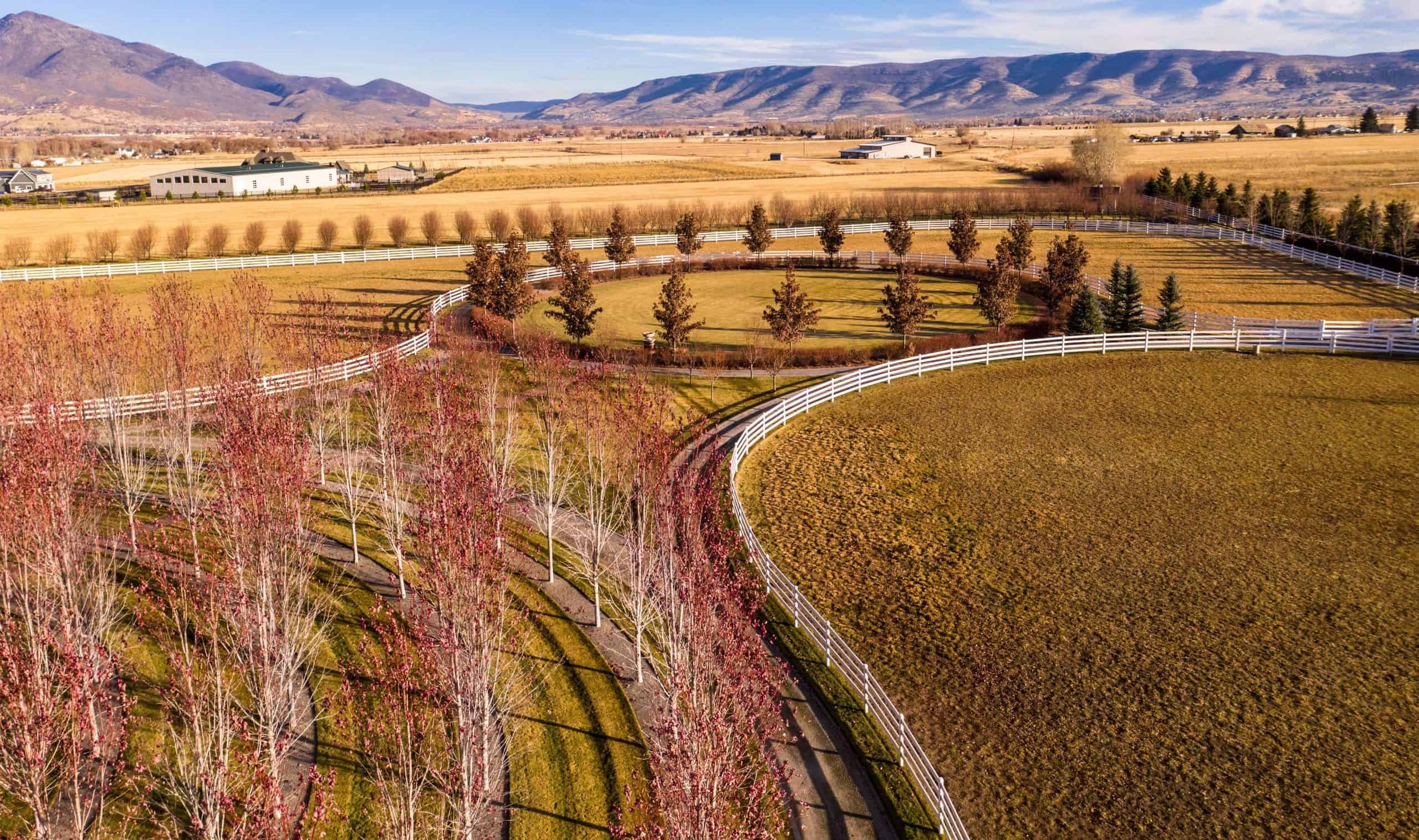There’s a conversation happening at every ranch gate and horse show across the country, and it usually starts with: “What’s the best way to keep our horses safe?” After spending three decades working with ranchers, horse trainers, and property owners, we’ve heard every fencing pitch and seen every containment solution out there.
Electric fencing for horses? It’s a topic that tends to spark strong opinions.
Here’s the thing about electric fencing: it’s not as simple as running a few charged wires and calling it done. We’ve walked thousands of property lines with folks just like you, looking to make the right choice for their horses and their land. Some swear by their electric systems, while others wouldn’t touch them with a 10-foot pole.
The truth is that it’s somewhere in the middle, and it depends entirely on your situation.
Below, we’ll give you the no BS truth about electric horse fencing. No sugar coating, no sales pitch—just straight talk about what works, what doesn’t, and what you need to know before making your decision. Let’s dig into the good, the bad, and yes, even the ugly. Your horses are counting on you to make the right call, and we’re here to help you do exactly that.
The Basics of Electric Fencing for Horses
Electric fencing is more than just the wires you see. It’s a complete circuit that includes your charger (some folks call it an energizer), grounding system, insulators, and the wiring itself. When a horse touches the fence, they complete that circuit, getting a short, sharp shock that’s meant to teach them to stay clear.
Now, we’re not talking about the kind of jolt that powers your house. A good horse fence energizer typically delivers short pulses of high voltage but very low amperage. Think of it like static electricity on steroids. It’s designed to get their attention, not cause harm. The psychology behind it is simple: horses learn to respect the boundary through that negative reinforcement.
Here’s what you’ll typically see out in the field: either a single hot wire mounted on existing fencing, multiple strands of electrified wire (usually 2-3 for horses), or electric tape or rope that’s more visible to your animals. That visibility factor is more important than some folks realize. Your horse needs to see what they’re supposed to avoid.
Basic materials run anywhere from $0.15 to $1.00 per foot, depending on what you choose. But here’s what the catalogs don’t always tell you: you’ll need a reliable power source, regular maintenance supplies, and likely some backup systems. Those “hidden” costs add up faster than you might expect.
For power, you’ve got choices:
- Standard plug-in chargers
- Battery-operated units
- Solar systems
Each comes with its own set of trade-offs between reliability, maintenance, and cost. Regardless, no matter which you choose, you’ll need a plan for when the power fails. Because it will, usually at the most inconvenient time possible.
The Good: Where Electric Fencing Works
After working with hundreds of property owners, we’ve seen electric systems shine in specific scenarios. When used right, in the right situation, electric fencing can be both effective and practical.
- Temporary Solutions: Perfect for rotational grazing or temporary paddocks. When you need to section off a pasture for a few weeks or create a quick containment area, electric fencing gives you that flexibility. Set it up, take it down, move it around all without breaking your back or your bank account.
- Secondary Barriers: As a backup to your primary fencing, electric wire can be a game-changer. We’ve seen it work wonders for keeping horses from leaning on board fences or deterring them from testing their boundaries.
- Budget Constraints: Sometimes, you need a solution that fits today’s budget while you save for something more permanent. Electric fencing can be that stepping stone, giving you safe containment without requiring a second mortgage.
- Large Acreage: When you’re fencing hundreds of acres, running traditional fencing gets expensive fast. Electric systems can help you manage those bigger spaces without breaking the bank.
- Predator Control: If you’re in mountain lion or wolf country, adding a hot wire to your existing fence can give you that extra layer of protection. We’ve seen it deter everything from coyotes to nosy neighbor dogs.
- Problem Solvers: Got a cribber? Or maybe a mare that’s determined to reach that grass on the other side? A strategic electric wire can help modify these behaviors without requiring a complete fence overhaul.
The Bad: Common Challenges with Electric Fences
We’ve helped enough ranchers and horse owners troubleshoot their fencing to know that every system has its drawbacks. With electric fencing, those challenges can range from minor inconveniences to serious safety concerns:
- Power Problems: Your fence is only as good as its charge. One failed battery, one blown fuse, one chewed wire from a curious critter, and suddenly your containment system isn’t containing anything.
- Weather Woes: Rain, snow, ice, heavy wind—they all affect your fence’s performance. Wet grass can short out lower wires, heavy snow can pull down your lines, and drought can make grounding nearly impossible.
- Maintenance Demands: Daily checks, weekly testing, constant vegetation management…well, electric fencing is needy. That bargain price tag starts looking different when you’re out there every morning with your voltage tester, trimming weeds, and fixing broken insulators.
- Training Time: Some horses catch on quick, others…not so much. You’ll need to invest time teaching each horse about the fence, and some never fully trust it. We’ve seen plenty of good horses get tangled up because they never learned to respect the boundary properly.
- Hidden Expenses: Sure, the initial setup might seem budget-friendly, but wait until you’re replacing chargers, batteries, insulators, and broken posts. Not to mention the cost of backup systems (because you will need backups). Those “little” expenses add up faster than feed bills in winter.
- Reliability Issues: Even when everything’s working perfectly, electric fencing isn’t fail-safe. Horses can run through it if spooked, wildlife can break wires, and sometimes they’ll test the fence right when the charge pulses low.
- Visual Limitations: Most electric fencing is hard for horses to see, especially at night or in bad weather. Even tape versions can become nearly invisible in certain conditions.
The Ugly: Major Safety Concerns for Horses
If you’re considering electric fencing, you need to know about these potential risks.
- Entanglement Issues: When a horse gets tangled in electric wire, things can go bad fast. The shock makes them panic, the panic leads to thrashing, and suddenly you’ve got a dangerous situation on your hands.
- Flight Response: Horses are flight animals. It’s in their DNA. When they get shocked unexpectedly, their natural instinct is to run first and think later. And you can imagine the trouble that might get them into with an electric fence.
- Wire Hazards: Electric fencing can break under pressure, creating loose wires that become serious hazards. Those thin strands can wrap around legs, cut into flesh, or even cause worse injuries when horses run through them at speed.
- Equipment Failure: When your electric fence fails, it often fails completely. We’re talking zero barriers between your horses and whatever’s on the other side. Unlike traditional fencing that might have a broken section, when electric fencing loses power, your entire perimeter is compromised.
- Wildlife Complications: Deer and other wildlife don’t understand electric fencing. When they run through it, they can take down sections of your fence, leaving dangerous gaps and loose wires.
- Multiple Horse Dynamics: Put several horses in a paddock, and the risks multiply. One horse gets spooked by a shock, crashes into another, and suddenly you’ve got a chain reaction of panic. In herd situations, electric fencing can turn a minor incident into a major problem.
- Weather-Related Risks: Ice storms can pull down wires, lightning can fry your system, and flooding can create dangerous electrical situations. Mother Nature has a way of turning these “secure” systems into serious hazards when conditions get rough.
When Electric Isn’t the Answer…
There are some situations where electric fencing for horses just isn’t the right choice. If you recognize your situation in any of these, you might want to consider other options:
- High-Traffic Areas: Your main paddocks, gate areas, and anywhere horses frequently gather need something more substantial. We’ve seen too many issues with horses testing electric fences when they’re crowded, excited, or just plain bored.
- Show Horses: When you’ve invested thousands in that championship horse, why risk it with electric? These athletes need clear, solid boundaries they can trust. The last thing you want is your show horse developing anxiety or behavior issues because of fence-related incidents.
- Property Perimeters: Your boundary line with public roads or neighboring properties isn’t the place to gamble with electric-only systems. One power failure, and suddenly your horses have access to places they definitely shouldn’t be.
- Young or Untrained Horses: Colts, fillies, and horses still learning the ropes need clear, visible boundaries. Electric fencing requires a level of understanding and respect that young horses simply haven’t developed yet. You’re asking for trouble expecting them to understand invisible boundaries.
- Breeding Operations: Stallions, mares in season, or mares with foals require extra-secure containment. The natural behaviors and hormones in these situations can make horses more likely to test or challenge electric fencing. When those maternal or breeding instincts kick in, a little shock isn’t always enough deterrent.
- Multi-Use Facilities: If you’re running a boarding facility or hosting events, electric fencing adds an extra layer of liability you probably don’t need. Different horses coming and going means constant retraining and increased risk of accidents.
An Alternative Fencing Solution You Can Trust
Through decades of experience and thousands of installations, we’ve found that steel board fencing offers everything that electric fencing promises (without the risks and constant maintenance).
The reliability factor alone tells a compelling story. No power failures, no weather concerns, no daily testing needed. Steel board fencing stands strong and secure every hour of every day, giving you the peace of mind that your horses are safely contained. It’s the kind of security that lets you actually sleep through the night.
Safety isn’t just a feature of steel board fencing: it’s built into its very design. Your horses get clear, visible boundaries they naturally understand and respect. There’s no shock-induced panic, no entanglement risks, and no hidden hazards. Our steel board fencing is engineered specifically for horses, working with their natural instincts rather than against them.
While the upfront investment might be higher than electric, think about what you’re really buying—decades of reliable service with minimal maintenance. No replacement parts, no system failures, no monthly testing. Just solid, dependable containment year after year. When you factor in the time and money saved on maintenance alone, steel board fencing often proves to be the more economical choice over time.
Steel board fencing doesn’t just work better…it looks better. The clean lines and professional appearance add real value to your property while showing everyone who visits that you take horse safety seriously.
Now, you can spend your time managing an electric fence, or you can spend it with your horses. You can worry about power failures and maintenance, or you can enjoy the peace of mind that comes with knowing your fencing is solid, secure, and reliable.
The choice is yours.
Ready to explore a better fencing solution? Let’s talk about your property and how we can help you create the safe, secure environment your horses deserve.



